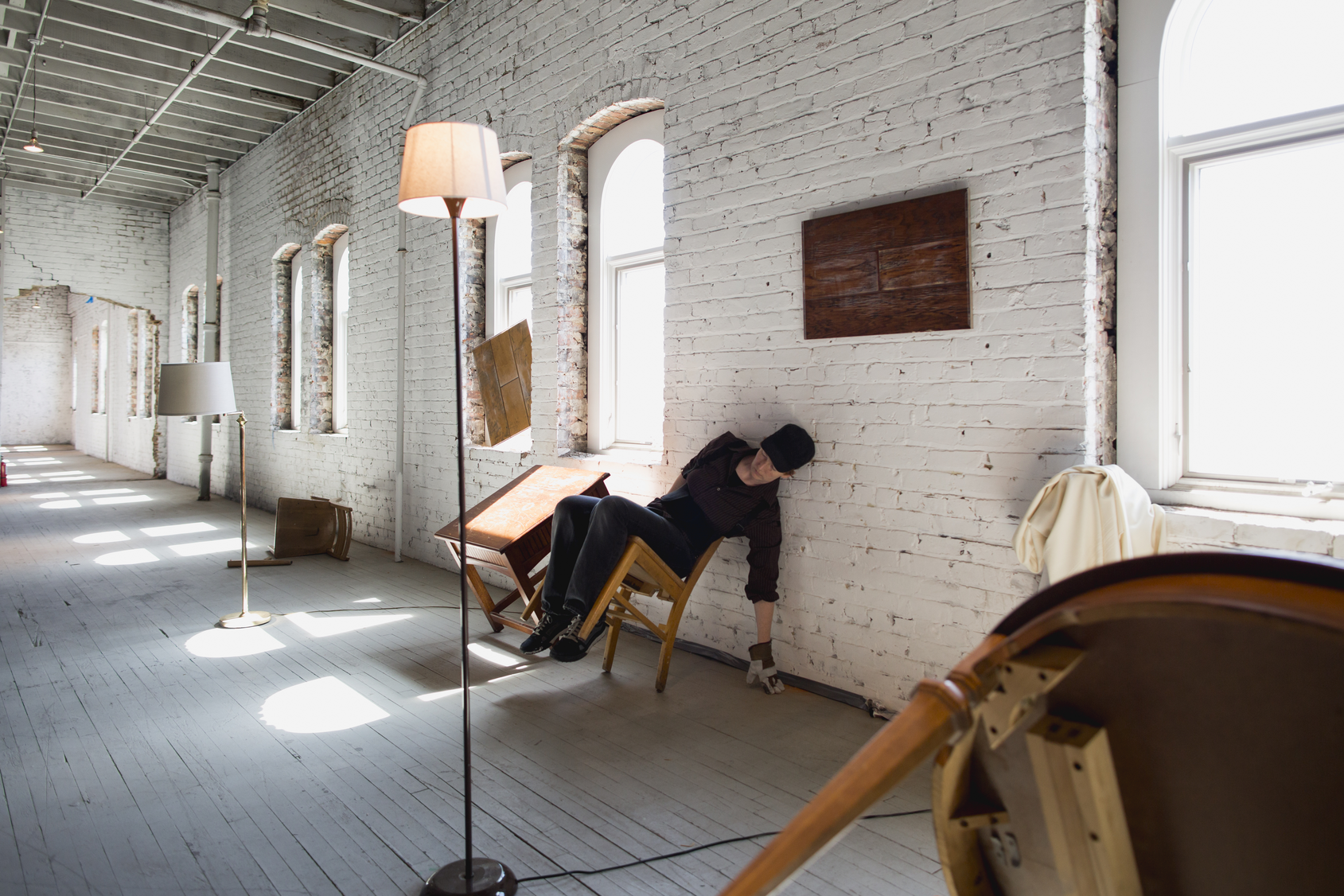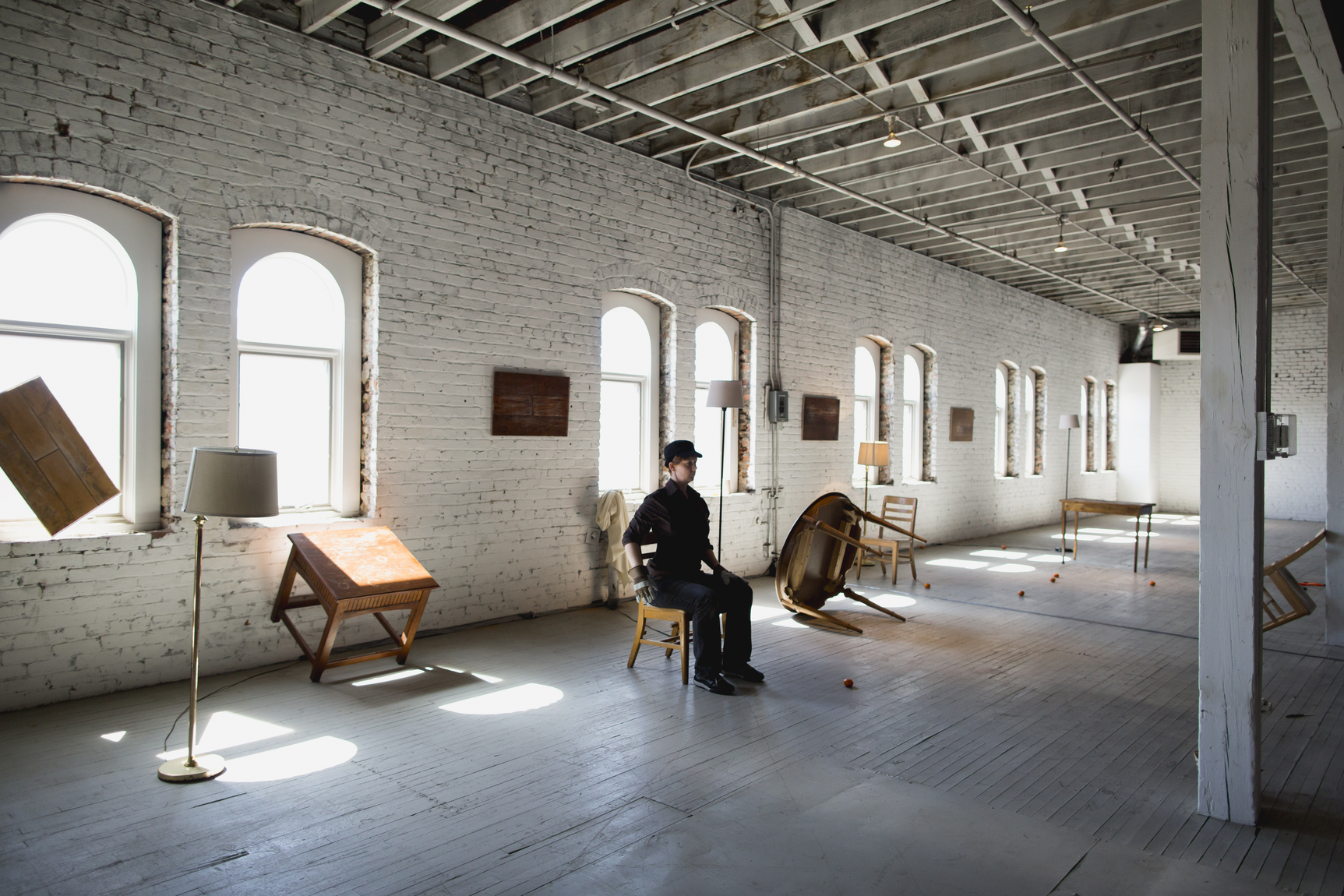‘We need to talk about what it means to feel agency. How do we experience our own empowerment as something that is healing, as something that enables us to become more resilient and more capable subjects? Foucault talks about this as an “increase in capacities”. Therapists won’t go to somebody who is traumatized or has substance abuse issues, and say, “Look, just get over it.” It comes down to creating a much subtler and more detailed scaffolding that gives traumatized bodies opportunities to nurture that feeling of agency, stepwise – to provide an increasing sense of their own agency and empowerment. One doesn’t simply say, on day one, “Get over it”. That’s where the ideology of will worries me. At the very least, whatever will is, we need to understand it as something that is not a metaphysical property but is something that is nurtured, something that is cultivated. It’s an effect of the circumstances, relationships, and economic location within which you find yourself. With that understanding, we can come to a much more textured appreciation of will.’
Donovan O. Schaefer in Donovan O. Schaefer, Matt Sheedy, and Nathan Rein, ‘“Trauma Makes You”: An Interview with Donovan O. Schaefer’, Bulletin for the Study of Religion, 45(2) (June 2016), p. 50
‘And the healing process might be miserable for awhile like, you might have to go through, you know, with your physical body, sometimes you have to go through physical therapy, and that’s a very painful experience, from what I hear. With our emotional lives, I feel like sometimes, the process of healing can be equally painful, but in a different way. Um. So, depending upon where we are in that journey, um, maybe it’s time to embrace the pain, and to work through it.’
Mike Bingeman, hospital chaplain, Lincoln, Nebraska
‘If something is ugly, say so. If it is tacky, inappropriate, out of proportion, unsustainable, morally degrading, ecologically impoverishing, or humanly demeaning, don’t let it pass. Don’t be stopped by the “if you can’t define it and measure it, I don’t have to pay attention to it” ploy. No one can precisely define or measure justice, democracy, security, freedom, truth, or love. No one can precisely define or measure any value. But if no one speaks up for them, if systems aren’t designed to produce them, if we don’t speak about them and point toward their presence or absence, they will cease to exist.’
Donella Meadows, ‘Dancing with Systems’, 2001
‘In the new science of complexity, which takes its inspiration from the web of life, we learn that nonequilibrium is a source of order. The turbulent flows of water and air, while appearing chaotic, are really highly organized, exhibiting complex patterns of vortices dividing and subdividing again and again at smaller and smaller scales. In living systems the order arising from nonequilibrium is far more evident, being manifest in the richness, diversity, and beauty of life all around us. Throughout the living world chaos is transformed into order.’
Fritjof Capra, The Web of Life: A New Scientific Understanding of Living Systems (New York: Anchor Books, 1996), p. 190
‘… the table in practical use does not exhaust the table’s reality. In one moment it reliably supports paperweights and our midday meal; in the next it collapses to the ground, shattering everything. This shows that just as the table could not be identified with the one we saw, it was also not the same as the one we used. The real table is a genuine reality deeper than any theoretical or practical encounter with it. And beyond this, if rocks or other weights slam into the table, they fail to exhaust its inner depths as well. The table is something deeper than any relations in which it might become involved, whether with humans or inanimate entities.’
Graham Harman, The Third Table, 100 Notes-100 Thoughts, dOCUMENTA 13, no. 85 (2012), p. 9–10
‘I think, in climate science, vulnerability is, it’s kind of peeling back the layers and seeing which segments of society would be more, likely to get, to be hurt.’
Theresa Jedd, political scientist, Drought Mitigation Center
Pine Trail Wallpaper (131105)
(Categorised as ‘Masculine’ by Johnson Wall Coverings, Galesburg, Illinois, USA)
2016
‘Human cognition involves language and abstract thinking, and thus symbols and mental representations, but abstract thought is only a small part of human cognition and generally is not the basis for our everyday decisions and actions. Human decisions are never completely rational but are always colored by emotions, and human thought is always embedded in the bodily sensations and processes that contribute to the full spectrum of cognition.’
Fritjof Capra, The Web of Life: A New Scientific Understanding of Living Systems (New York: Anchor Books, 1996), p. 274
‘All ecological fluctuations take place between tolerance limits. There is always the danger that the whole system will collapse when a fluctuation goes beyond those limits and the system can no longer compensate for it. The same is true of human communities. Lack of flexibility manifests itself as stress. In particular, stress will occur when one or more variables of the system are pushed to their extreme values, which induces increased rigidity throughout the system. Temporary stress is an essential aspect of life, but prolonged stress is harmful and destructive to the system. These considerations lead to the important realization that managing a social system – a company, a city, or an economy – means finding the optimal values for the system’s variables. If one tries to maximize any single variable instead of optimizing it, this will invariably lead to the destruction of the system as a whole. The principle of flexibility also suggests a corresponding strategy of conflict resolution. In every community there will invariably be contradictions and conflicts, which cannot be resolved in favor of one or the other side. For example, the community will need stability AND change, order AND freedom, tradition AND innovation. Rather than by rigid decisions, these unavoidable conflicts are much better resolved by establishing a dynamic balance. Ecological literacy includes the knowledge that both sides of a conflict can be important, depending on the context, and that the contradictions within a community are signs of its diversity and vitality and thus contribute to the system’s viability.’
Fritjof Capra, The Web of Life: A New Scientific Understanding of Living Systems (New York: Anchor Books, 1996), p. 303
‘When a second observer sees what the first one does not see – thus, when he observes an observer observing – this is called second-order observation. This observation of observation sees “what the observer sees and how he sees what he sees. It even sees what the observed observer does not see, and sees that he does not see what he does not see.” But in order to see all of that, the second-order observation has to use a distinction that remains invisible to it, since only by means of this distinction is it able to observe what it observes. In terms of this operatively applied distinction, a second-order observation is also a first-order observation, which also results in a paradox, since it is simultaneously something and something else. “Each [observer] observes what he is capable of on the basis of his own paradox, invisible to himself, and based on a distinction whose unity is inaccessible to his observation.” Here observation is conceived not in terms of the human being but rather systemically, “highly abstractly and independently of the material substrate, the infrastructure or the specific manner of observation.”’
Christian Katti, extracts from ‘Systematically Observing Surveillance: Paradoxes of Observation According to Niklas Luhmann’s Systems Theory’ (1999), in CTRL [SPACE]: Rhetorics of Surveillance from Bentham to Big Brother, ed. by Thomas Y. Levin et al. (Karlsruhe: ZKM; Cambridge, MA: MIT Press, 2002), pp. 51–63
‘And, it’s not that I let it go: and I’m not going to bury it again, because when it does come out with a vengeance, then, uh, you know, it’s hard to deal with, it’s very difficult. And as a veteran, I know the things that I can and can’t do –’
Bert Leaverton, artist and veteran, Omaha, Nebraska
‘The crucial role of language in human evolution was not the ability to exchange ideas, but the increased ability to cooperate.’
Fritjof Capra, The Web of Life: A New Scientific Understanding of Living Systems (New York: Anchor Books, 1996), p. 294
‘Today we know that most organisms are not only members of ecological communities but are also complex ecosystems themselves, containing a host of smaller organisms that have considerable autonomy and yet are integrated harmoniously into the functioning of the whole. So there are three kinds of living systems – organisms, parts of organisms, and communities of organisms – all of which are integrated wholes whose essential properties arise from the interactions and interdependence of their parts.’
Fritjof Capra, The Web of Life: A New Scientific Understanding of Living Systems (New York: Anchor Books, 1996), p. 34
‘I guess I’ve just learned to work with the structure of my body as it is and to strengthen certain things and stretch things and just know that I can’t live my life the way I did before –’
Sarah Berkeley, artist, Lincoln, Nebraska
‘The organization of a living system, they explain, is the set of relations among its components that characterize the system as belonging to a particular class (such as a bacterium, a sunflower, a cat, or a human brain). The description of that organization is an abstract description of relationships and does not identify the components. The authors assume that autopoiesis is a general pattern of organization, common to all living systems, whichever the nature of their components. The structure of a living system, by contrast, is constituted by the actual relations among the physical components. In other words, the system’s structure is a physical embodiment of its organization. Maturana and Varela emphasize that the system’s organization is independent of the properties of its components, so that a given organization can be embodied in many different manners by many different kinds of components.’
Fritjof Capra, The Web of Life: A New Scientific Understanding of Living Systems (New York: Anchor Books, 1996), p. 98
‘In one of the greatest coups of all time, the [blue-green] bacteria invented a metabolic system that required the very substance that had been a deadly poison. … The breathing of oxygen is an ingeniously efficient way of channeling and exploiting the reactivity of oxygen. It is essentially controlled combustion that breaks down organic molecules and yields carbon dioxide, water, and a great deal of energy in the bargain. … The microcosm did more than adapt: it evolved an oxygen-using dynamo that changed life and its terrestrial dwelling place forever.’
Lynn Margulis and Dorion Sagan, quoted in Fritjof Capra, The Web of Life: A New Scientific Understanding of Living Systems (New York: Anchor Books, 1996), p. 241
‘Living successfully in a world of complex systems means expanding not only time horizons and thought horizons; above all it means expanding the horizons of caring. There are moral reasons for doing that, of course. And if moral arguments are not sufficient, then systems thinking provides the practical reasons to back up the moral ones. The real system is interconnected. No part of the human race is separate either from other human beings or from the global ecosystem. It will not be possible in this integrated world for your heart to succeed if your lungs fail, or for your company to succeed if your workers fail, or for the rich in Los Angeles to succeed if the poor in Los Angeles fail, or for Europe to succeed if Africa fails, or for the global economy to succeed if the global environment fails.’
Donella Meadows, ‘Dancing with Systems’, 2001
PROJECT BIBLIOGRAPHY
Burnham, Jack, ‘Real Time Systems’, Artforum, 8(1) (September 1969)
Burnham, Jack, ‘Systems Aesthetics’, Artforum, 7(1) (September 1968)
Chesapeake Wall Coverings, ‘Pine Trail Wallpaper (131105)’ (categorised as ‘Masculine’ and distributed by Johnson Wall Coverings, 2016). <http://www.johnsonwallcoverings.com/htm51162.html> [accessed 15 July 2016]
Capra, Fritjof, The Web of Life: A New Scientific Understanding of Living Systems (New York: Anchor Books, 1996)
Eno, Brian, ‘Generating and Organizing Variety in the Arts’, Studio International, 193 (November/December 1976); reprinted in Audio Culture: Readings in Modern Music, ed. by Christoph Cox and Daniel Warner (London: Bloomsbury Academic, 2004)
Harman, Graham, The Third Table, 100 Notes-100 Thoughts, dOCUMENTA 13, no. 85 (2012)
Haque, Usman, ‘The Architectural Relevance of Gordon Pask’, Architechtural Design (special issue: ‘4Dsocial: Interactive Design Environments’), 77(4) (July/August 2007), 54–61
Hudsonia Ltd. ‘Habitat Fact Sheets’, <http://hudsonia.org/programs/biodiversity-resources-center/habitat-mapping/habitat-fact-sheets/> [accessed 25 May 2016]
Katti, Christian, ‘Systematically Observing Surveillance: Paradoxes of Observation According to Niklas Luhmann’s Systems Theory’ (1999), in CTRL [SPACE]: Rhetorics of Surveillance from Bentham to Big Brother, ed. by Thomas Y. Levin et al. (Karlsruhe: ZKM; Cambridge, MA: MIT Press, 2002)
Latour, Bruno, ‘Some Experiments in Art and Politics’, e-flux Journal (March 2011)
Luhhman, Niklas, Art as a Social System (Frankfurt am Main, 1995); trans. by Eva M. Knodt (Stanford, CA: Stanford University Press, 2000)
Maturana, Humberto, et al., The Tree of Knowledge: Biological Roots of Human Understanding (Boston, MA: Shambhala Publications, 1987)
Meadows, Donella, ‘Dancing with Systems’, 2001, Donella Meadows Institute <http://donellameadows.org/archives/dancing-with-systems/> [accessed 22 March 2016]
Pask, Gordon, ‘The Architectural Relevance of Cybernetics’, Architectural Design, September (1969), 494–96.
Phillips, Jack, ‘A Pocket Guide to Sauntering’, New Tree School, 2015
Schaefer, Donovan O., Matt Sheedy, and Nathan Rein, ‘“Trauma Makes You”: An Interview with Donovan O. Schaefer’, Bulletin for the Study of Religion, 45(2) (June 2016)
Sokefeld, Martin, Spaces of Conflict in Everyday Life: Perspectives Across Asia (Bielefeld: Transcript Verlag, 2015), pp. 23–24
Steyerl, Hito, "In Free Fall, a Thought Experiment on Vertical Perspective,“ from The Wretched of the Screen, Sternberg Press, 2012
Sommerer, Christa, et al., ‘Art as a Living System’, Leonardo, 32(3) (June 1999)
INTERVIEWS
Alicia Armentrout, child care specialist, resident of Omaha, Nebraska
Sarah Berkeley, artist, resident of Lincoln, Nebraska
Mike Bingeman, hospital chaplain, Lincoln, Nebraska
Kate Bradshaw, animal behaviour specialist, Nebraska Humane Society
Shelbi Bretz, teacher, resident of Lincoln, Nebraska
Peter Cales, artist, resident of Omaha, Nebraska
Sean Fader, artist-in-residence, Bemis Center for Contemporary Art
Alex Ferrer, physical trainer, YMCA Omaha
Theresa Jedd, political scientist, Drought Mitigation Center
Jill Y. Blanchard Kraft, housekeeper and tribal community member, New York
Bert Leaverton, artist and veteran, resident of South Omaha, Nebraska
Jamie Morra, site manager and art historian, Clermont, NY
Emily Nohner, humanitarian professional, resident of Omaha, Nebraska
Jill Pelletier, housekeeper and volunteer horse caretaker, New York
Jack Phillips, naturalist, Hitchcock Nature Center
Anne-Katrin Spiess, artist and landowner, Clermont, NY
Toisha Tucker, artist-in-residence, Bemis Center for Contemporary Art
Jessica M. Toro, conservation and restoration planning specialist, New York
Jave Yoshimoto, artist, resident of Omaha, Nebraska
Audio description by Katie Murphy
some Audio Readings by Meghan Moe Beitiks








